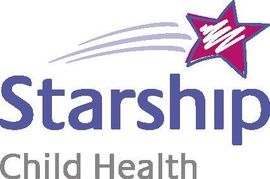Central Auckland > Public Hospital Services > Starship Child Health >
Starship Paediatric Spine Service
Public Service, Spinal, Orthopaedics, Paediatrics
Kyphosis (Postural, Scheuermann's, Congenital)
Kyphosis is the term used to describe the forward curvature of the thoracic spine. Everyone has this normal rounding of the upper back. The acceptable range of thoracic kyphosis is from 20 - 45 degrees. A curvature of the thoracic spine that is greater than 45 - 50 degrees is considered excessive.
There are many different causes for kyphosis of the spine, but in children there are three specific types:
1. Postural kyphosis
Excessive kyphosis may simply be postural and can often be corrected with exercises and proper posture. Postural kyphosis is due to stretching of the ligaments, with the vertebrae themselves being normally formed. This type of kyphosis is mobile (voluntarily corrected). Most postural kyphosis straightens by itself as your child matures.
2. Scheuermann's kyphosis
A small percentage of children/adolescents with kyphosis have a more rigid deformity than the postural type. This is called Scheuermann’s Kyphosis. This type of kyphosis is the most common cause of structural kyphosis of the thoracic and thoracolumbar spine. Several of the vertebrae develop into a wedge shape. Their shape is narrower in the front (anterior) of the spine. This narrowing causes the spine to curve abnormally as your child grows. This type of kyphosis is fixed and cannot be corrected voluntarily.
Scheuermann’s Kyphosis usually develops during the early teens (12-15 years). During this period of rapid growth, a growth disturbance of the thoracic vertebrae occurs. Its cause is unknown but there is often a strong hereditary tendency. The incidence of Scheuermann’s Kyphosis is 0.4% - 0.8% and is twice as common in females. A minor scoliosis is also present in 25% of children but usually does not require treatment. Biomechanical factors play a large role in the progression of Scheuermann’s Kyphosis. As the kyphosis (hunching) increases, cartilage growing in front of the spine is placed under increasing pressure, causing the growth of the cartilage to slow. This slowed growth in front of the spine coupled with faster growth in the back of the spine (the posterior elements) worsens the kyphosis.
3. Congenital kyphosis
Congenital Kyphosis is the name given to defects of vertebrae of the spine that are present at birth. The most common birth defect is called hemivertebra, which means half of one side of a vertebra forms while the other side doesn’t (failure of formation). The vertebra appears wedge shaped. Another defect is called a unilateral bar (failure of segmentation). Several vertebra are “stuck” or fused together on the anterior (front) portion of the vertebrae. As the spine matures, only the posterior portion (back) of the spine is able to grow. This results in an increasing curvature of the spine. There is no known cause for these defects. Congenital kyphosis may be quite significant and evolves rapidly during the first years of life. Children with a congenital kyphosis are more likely to have other problems as well. Kidney or urinary tract abnormalities, abnormalities of spinal cord development, and congenital heart defects are some of the problems that may be present. If your doctor is concerned he may organise tests to exclude these conditions.
What is the treatment for kyphosis?
Braces are rarely used. They are poorly tolerated by children as they are uncomfortable and restrict activity.
1. Postural kyphosis
Exercises may be prescribed to strengthen the muscles that straighten the upper back and to prevent excessive lumbar lordosis. Exercises that relax and lengthen the “tight” thigh (hamstring) muscles may also be beneficial. A physiotherapist will teach an exercise regimen to your child and sets up a home program. The physiotherapist should periodically see your child, to ensure that the exercises continue to be done properly.
2. Scheuermann's kyphosis
Goals of treatment
- Correct or lessen the curvature and to stabilise the affected area of the spine
- Improve the cosmetic appearance
- Decrease discomfort or postural fatigue
(1) Observation
Often, no treatment is necessary. For curves less than 60 degrees, regular assessment and x-rays will be required until your child finishes growing (skeletal maturity). Progression of the curve depends upon the amount of skeletal growth, or how skeletally mature, your child is. Curve progression slows down or stops after your child reaches puberty.
(2) Surgery
If the curve in your child’s spine continues to increase in severity and persistent back pain is unresponsive to non operative treatment, your doctor may recommend surgery. This is called a spinal fusion. A spinal fusion involves instrumentation and bone graft. The term “instrumentation” refers to a variety of metal rods, hooks, wires and screws, which are used to hold the correction of the spine whilst the bone fusion heals.
3. Congenital kyphosis
Goals of treatment
- To allow the child to reach the end of growth with a reasonably straight, balanced spine.
- To allow the spine to grow as much as possible.
- For younger children, allowing for the chest cavity to grow and develop and allowing the lungs to increase in size.
- Prevent compression of the spinal cord which can lead to nerve damage or even paralysis.
In very mild forms treatment may be delayed, however most cases require prompt and thorough evaluation as well as early surgical treatment. With congenital kyphosis, surgery is usually performed while the child is still growing because there is a significant chance of compression on the spinal cord if the curve continues to increase.

